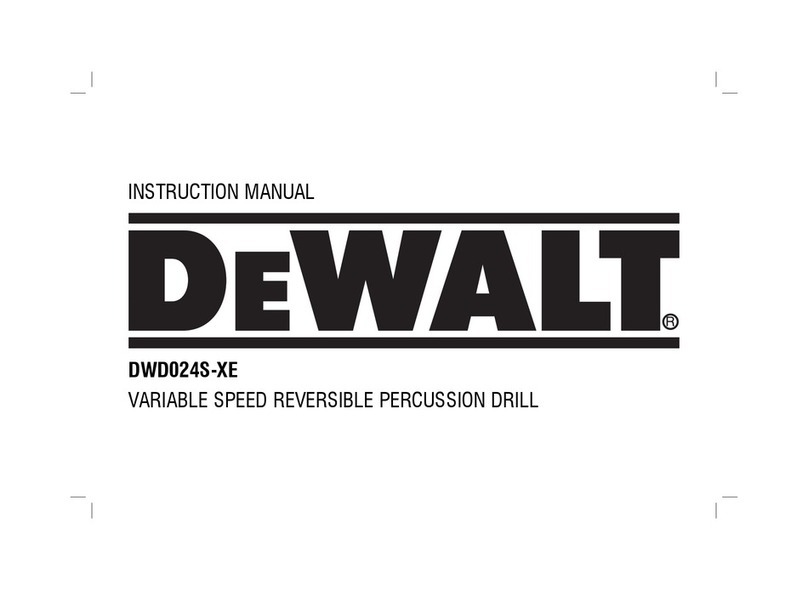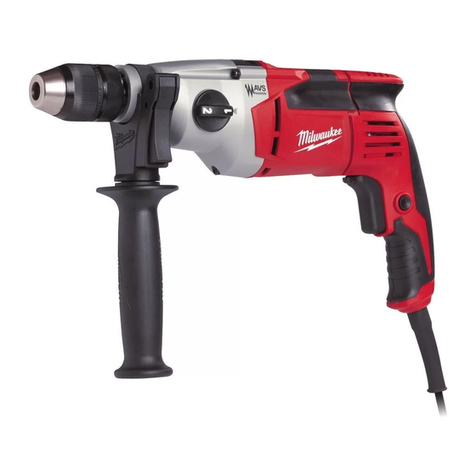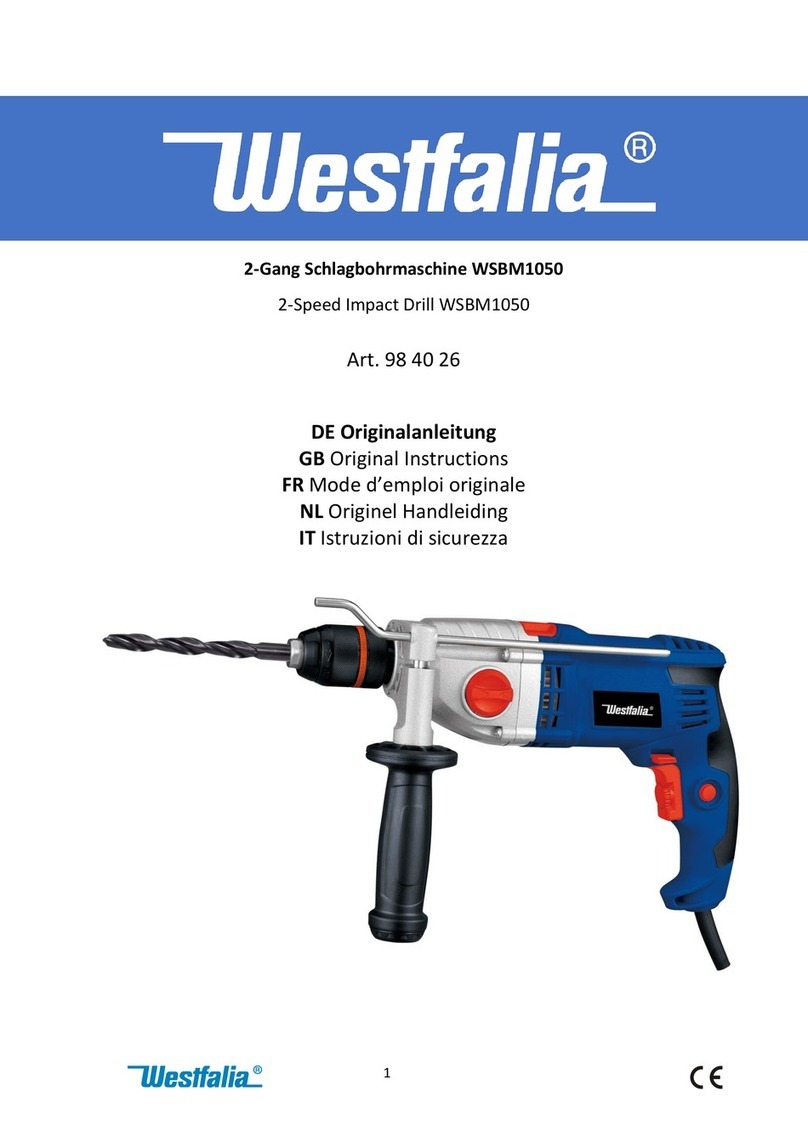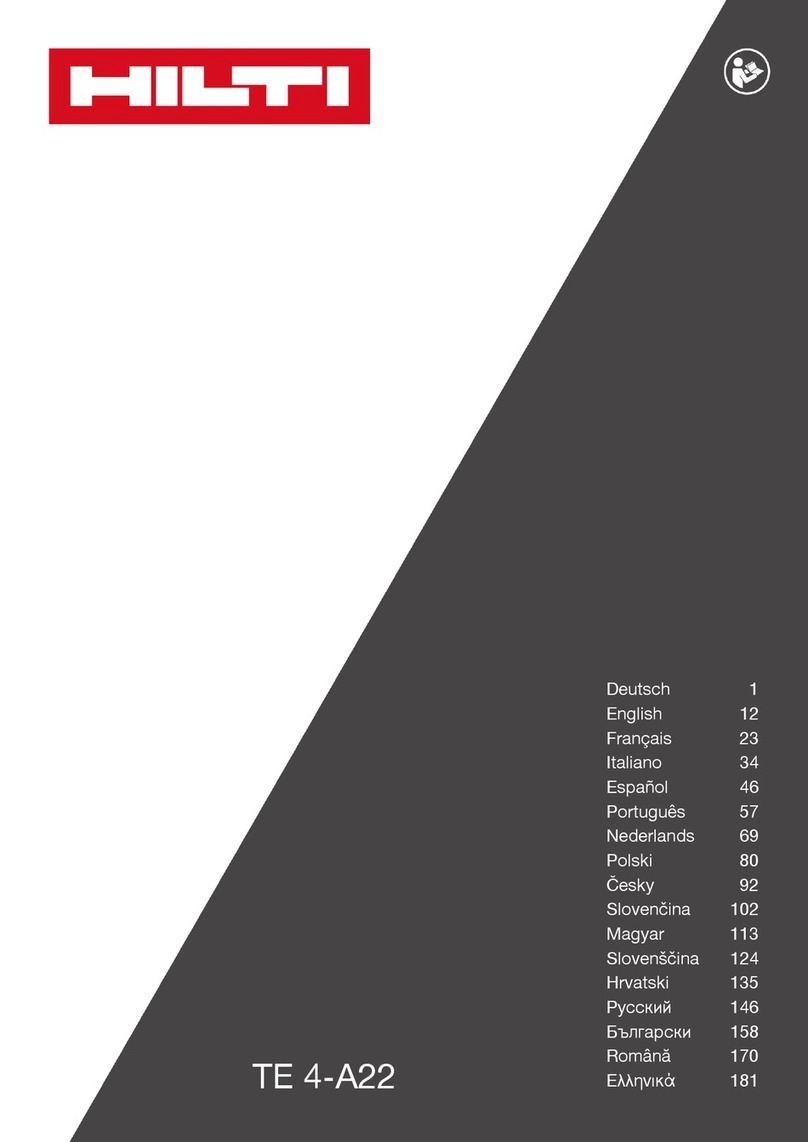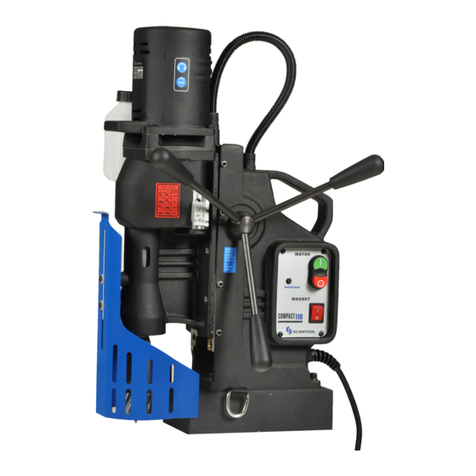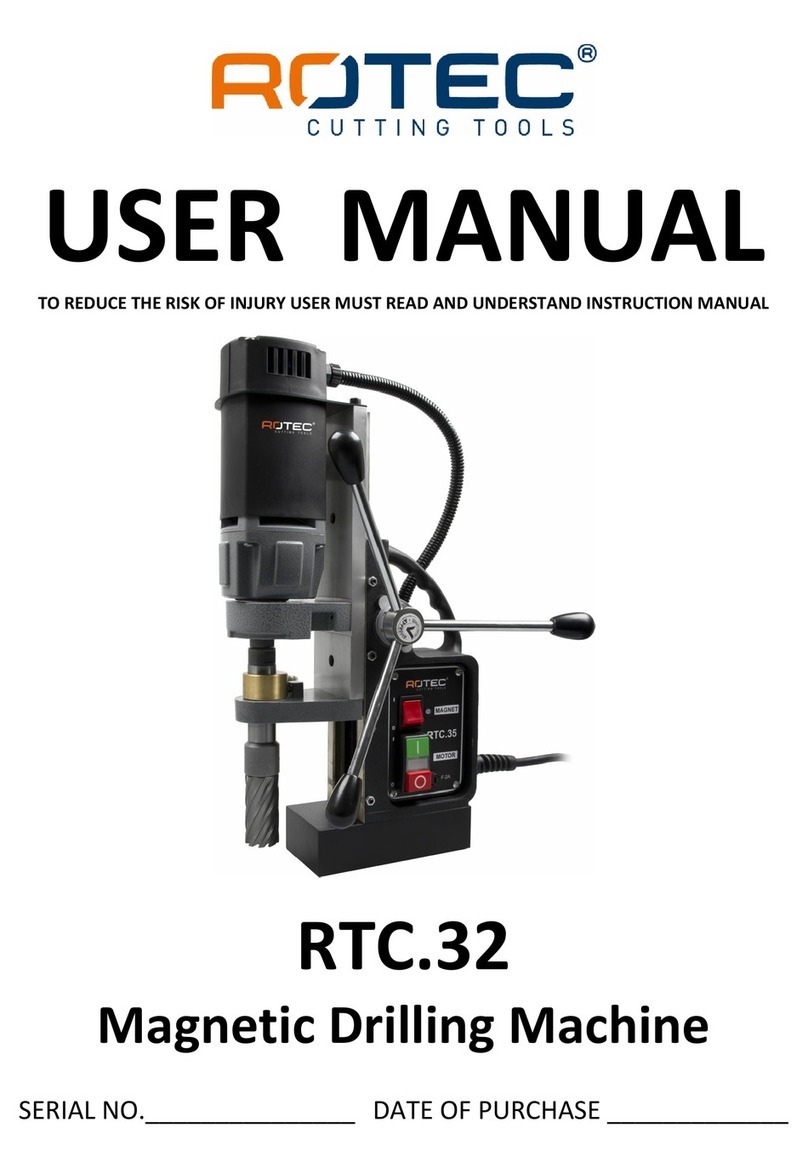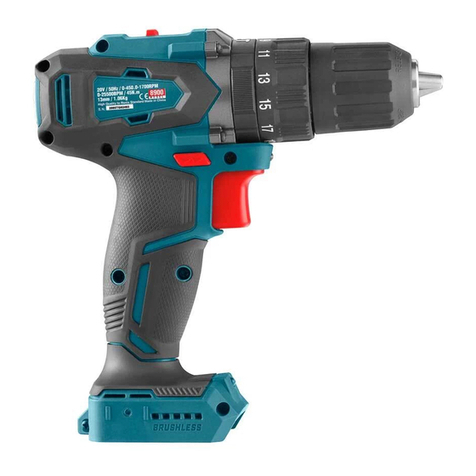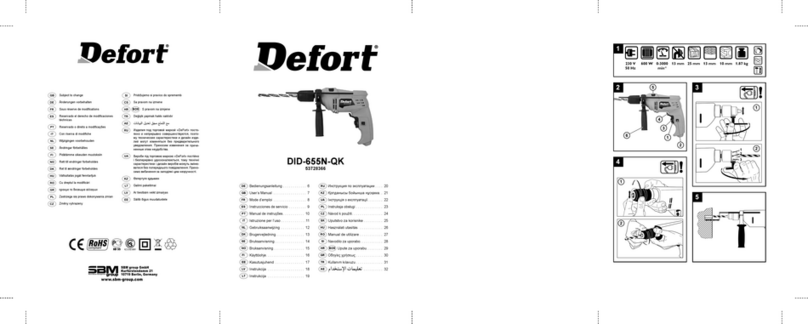Shopseries SS2811 User manual

SS2811
SS2811K.1
3/8˝ DRILL DRIVER PAGE 5 ENG
3/8˝(10MM) TALADRO DESTORNILLADOR PAGE 12 ESP
10MM(3/8 ˝) ENTRAÎNEMENT DE PERCEUSE PAGE 20 FRE
Certified to CSA Std.
C22.2 No.60745-1,
60745-2-1,60745-2-2
Conforms to UL Std.
60745-1,60745-2-1,60745-2-2
3025735

shopseries service number
866-447-7467

SS2811 SS2811K.1
A
CD1
B1 B2
12
3
4
7
8
6
5
D2

SS2811 SS2811K.1
EF

5
3/8˝ DRILL DRIVER ENG
COMPONENT LIST
KEYLESS CHUCK
TORQUE ADJUSTMENT RING
FORWARD/REVERSE ROTATION CONTROL
SOFT GRIP HANDLE
BATTERY PACK
BATTERY PACK RELEASE BUTTON
LED LIGHT
ON/OFF SWITCH
Not all the accessories illustrated or described are included in standard delivery.
1
2
3
4
5
6
7
8
ACCESSORIES
SS2811
Battery pack (ABP118W6) 1
Charger (ACG318WU) 1
Double ended bits (PH2/SL5.5) 1
SS2811K.1
Battery pack (ABP118W6) 1
Charger (ACG318WU) 1
Magnetic bit holder (2”/50mm) 1
Tape measure (10’/3m) 1
Pliers 1
Level 1
Knife 1
Screwdriver (flat head/philips) 2
Spade bits (10/12/16/20/25mm) 5
Metal drill bits 10
(1.6,2,2.5,3,3.2,3.6,4.4,4.8,6.35,8mm)
50mm bits 10
(SL4/SL6,T20/T25,PH1/PH2/PH3,PZ1/PZ2/PZ3)
25mm bits 10
(SL4/SL6,T20/T25, PH1/PH2/PH3,PZ1/PZ2/PZ3)
We recommend that you purchase your accessories
listed in the above list from the same store that sold you
the tool. Refer to the accessory packaging for further
details. Store personnel can assist you and offer advice.
California proposition 65:
WARNING:
Some dust created by power
sanding, sawing, grinding, drilling and other
construction activities contains chemicals known to the
state of California to cause cancer, birth defects or other
reproductive harm. Some examples of these chemicals
are:
• Lead from lead-based paints;
• Crystalline silica from bricks and cement and other
masonry products;
• Arsenic and chromium from chemically-treated
lumber.
Your risk from these exposures varies, depending on how
often you do this type of work. To reduce your exposure
to these chemical: work in a well ventilated area, and
work with approved safety equipment, such as those
dust masks that are specially designed to filter out
microscopic particles.
WARNING :
This product can expose you to
chemicals including lead, phthalate or bisphenol
A which are known to the State of California to cause
cancer, birth defects or other reproductive harm. Wash
your hands after use. For more information go to www.
P65Warnings.ca.gov.

3/8˝ DRILL DRIVER ENG
6
GENERAL POWER TOOL SAFETY
WARNINGS
WARNING: Read all safety warnings and
instructions. Failure to follow the warnings
and instructions may result in electric shock, fire and/or
serious injury.
Save all warnings and instructions for future
reference.
The term “power tool” in the warnings refers to your
mains-operated (corded) power tool or battery-operated
(cordless) power tool.
1. WORK AREA SAFETY
a) Keep work area clean and well lit. Cluttered or
dark areas invite accidents.
b) Do not operate power tools in explosive
atmospheres, such as in the presence of
ammable liquids, gases or dust. Power tools
create sparks which may ignite the dust or fumes.
c) Keep children and bystanders away while
operating a power tool. Distractions can cause
you to lose control.
2. ELECTRICAL SAFETY
a) Power tool plugs must match the outlet. Never
modify the plug in any way. Do not use any
adapter plugs with earthed (grounded) power
tools. Unmodified plugs and matching outlets will
reduce risk of electric shock.
b) Avoid body contact with earthed or grounded
surfaces such as pipes, radiators, ranges and
refrigerators. There is an increased risk of electric
shock if your body is earthed or grounded.
c) Do not expose power tools to rain or wet
conditions. Water entering a power tool will
increase the risk of electric shock.
d) Do not abuse the cord. Never use the cord
for carrying, pulling or unplugging the power
tool. Keep cord away from heat, oil, sharp
edges or moving parts. Damaged or entangled
cords increase the risk of electric shock.
e) When operating a power tool outdoors, use an
extension cord suitable for outdoor use. Use of
a cord suitable for outdoor use reduces the risk of
electric shock.
f) If operating a power tool in a damp location
is unavoidable, use a residual current device
(RCD) protected supply. Use of an RCD reduces
the risk of electric shock.
3. PERSONAL SAFETY
a) Stay alert, watch what you are doing and
use common sense when operating a power
tool. Do not use a power tool while you are
tired or under the inuence of drugs, alcohol
or medication. A moment of inattention while
operating power tools may result in serious personal
injury.
b) Use personal protective equipment. Always
wear eye protection. Protective equipment such
as dust mask, non-skid safety shoes, hard hat, or
hearing protection used for appropriate conditions
will reduce personal injuries.
c) Prevent unintentional starting. Ensure the
switch is in the off-position before connecting
to power source and/or battery pack, picking
up or carrying the tool. Carrying power tools with
your finger on the switch or energizing power tools
that have the switch on invites accidents.
d) Remove any adjusting key or wrench before
turning the power tool on. A wrench or a key left
attached to a rotating part of the power tool may
result in personal injury.
e) Do not overreach. Keep proper footing and
balance at all times. This enables better control
of the power tool in unexpected situations.
f) Dress properly. Do not wear loose clothing or
jewelry. Keep your hair, clothing and gloves
away from moving parts. Loose clothes, jewelry
or long hair can be caught in moving parts.
g) If devices are provided for the connection
of dust extraction and collection facilities,
ensure these are connected and properly
used. Use of dust collection can reduce dust-related
hazards.
4. POWER TOOL USE AND CARE
a) Do not force the power tool. Use the correct
power tool for your application. The correct
power tool will do the job better and safer at the rate
for which it was designed.
b) Do not use the power tool if the switch does

7
3/8˝ DRILL DRIVER ENG
not turn it on and off. Any power tool that cannot
be controlled with the switch is dangerous and must
be repaired.
c) Disconnect the plug from the power source
and/or the battery pack from the power tool
before making any adjustments, changing
accessories, or storing power tools. Such
preventive safety measures reduce the risk of
starting the power tool accidentally.
d) Store idle power tools out of the reach of
children and do not allow persons unfamiliar
with the power tool or these instructions
to operate the power tool. Power tools are
dangerous in the hands of untrained users.
e) Maintain power tools. Check for misalignment
or binding of moving parts, breakage of parts
and any other condition that may affect the
power tool’s operation. If damaged, have the
power tool repaired before use. Many accidents
are caused by poorly maintained power tools.
f) Keep cutting tools sharp and clean. Properly
maintained cutting tools with sharp cutting edges
are less likely to bind and are easier to control.
g) Use the power tool, accessories and tool bits
etc., in accordance with these instructions
and in the manner intended for the particular
type of power tool, taking into account
the working conditions and the work to be
performed. Use of the power tool for operations
different from those intended could result in a
hazardous situation.
5. BATTERY TOOL USE AND CARE
a) Recharge only with the charger specied by
the manufacturer. A charger that is suitable for
one type of battery pack may create a risk of fire
when used with another battery pack.
b) Use power tools only with specically
designated battery packs. Use of any other
battery packs may create a risk of injury and fire.
c) When battery pack is not in use, keep it away
from other metal objects, like paper clips,
coins, keys, nails, screws or other small metal
objects, that can make a connection from
one terminal to another. Shorting the battery
terminals together may cause burns or a fire.
d) Under abusive conditions, liquid may be
ejected from the battery; avoid contact. If
contact accidentally occurs, ush with water.
If liquid contacts eyes, additionally seek
medical help. Liquid ejected from the battery may
cause irritation or burns.
6. SERVICE
a) Have your power tool serviced by a
qualied repair person using only identical
replacement parts. This will ensure that the
safety of the power tool is maintained.
DRILL SAFETY WARNINGS
1. Hold power tool by insulated gripping
surfaces, when performing an operation
where the cutting accessory may contact
hidden wiring. Cutting accessory contacting a
“live” wire may make exposed metal parts of the
power tool “live” and could give the operator an
electric shock.
SAFETY INSTRUCTIONS FOR
YOUR BATTERY CHARGER
Information for radiated emission
This device complies with Canadian ICES-001.
This device complies with Part 15 of the FCC Rules.
Operation is subject to the following two conditions:
(1) This device may not cause harmful interference, and
(2) This device must accept any interference received,
including interference that may cause undesired
operation.
Warning: Changes or modifications to this unit not
expressly approved by the party responsible for
compliance could void the user’s authority to operate
the equipment.
- NOTE: This equipment has been tested and found
to comply with the limits for a Class B digital device,
pursuant to Part 15 of the FCC Rules.
These limits are designed to provide reasonable
protection against harmful interference in a residential
installation. This equipment generates, uses and can
radiate radio frequency energy and, if not installed and
used in accordance with the instructions, may cause
harmful interference to radio communications.
However, there is no guarantee that interference will
not occur in a particular installation. If this equipment
does cause harmful interference to radio or television
reception, which can be determined by turning the

3/8˝ DRILL DRIVER ENG
8
equipment off and on, the user is encouraged to try to
correct the interference by one or more of the following
measures:
• Reorient or relocate the receiving antenna.
• Increase the separation between the equipment
and receiver.
• Connect the equipment into an outlet on a
circuit different from that to which the receiver is
connected.
• Consult the dealer or an experienced radio/TV
technician for help.
SAFETY WARNINGS FOR
BATTERY PACK
a) Do not dismantle, open or shred battery pack.
b) Do not expose battery pack to heat or re.
Avoid storage in direct sunlight.
c) Do not short-circuit a battery pack. Do not
store battery packs haphazardly in a box or
drawer where they may short-circuit each
other or be short-circuited by other metal
objects. When battery pack is not in use, keep it
away from other metal objects, like paper clips,
coins, keys, nails, screws or other small metal
objects, that can make a connection from one
terminal to another. Shorting the battery terminals
together may cause burns or fire.
d) Do not remove battery pack from its original
packaging until required for use.
e) Do not subject battery pack to mechanical
shock.
f) In the event of battery leaking, do not allow
the liquid to come in contact with the skin
or eyes. If contact has been made, wash the
affected area with copious amounts of water
and seek medical advice.
g) Observe the plus (+) and minus (–) marks on
the battery back and equipment and ensure
correct use.
h) Do not use any battery pack which is not
designed for use with the equipment.
i) Keep battery pack out of the reach of children.
j) Seek medical advice immediately if a cell or
battery has been swallowed.
k) Always purchase the battery pack
recommended by the device manufacturer for
the equipment.
l) Keep battery pack clean and dry.
m) Wipe the battery pack terminals with a clean
dry cloth if they become dirty.
n) Battery pack need to be charged before use.
Always use the correct charger and refer to
the manufacturer’s instructions or equipment
manual for proper charging instructions.
o) Do not leave battery pack on prolonged
charge when not in use.
p) After extended periods of storage, it may be
necessary to charge and discharge the battery
pack several times to obtain maximum
performance.
q) Battery pack gives its best performance when
it is operated at normal room temperature (20
°C ± 5 °C).
r) When disposing of battery packs, keep battery
packs of different electrochemical systems
separate from each other.
s) Recharge only with the charger specied by
manufacturer. Do not use any charger other
than that specically provided for use with
the equipment. A charger that is suitable for one
type of battery pack may create a risk of fire when
used with another battery pack.
t) Retain the original product literature for
future reference.
u) Use only the battery pack in the application
for which it was intended.
v) Remove the battery pack from the equipment
when not in use.
w) Dispose of properly.
SYMBOLS
To reduce the risk of injury, user must read
instruction manual
Warning
Wear ear protection
Wear eye protection
Wear dust mask
Double insulation

9
3/8˝ DRILL DRIVER ENG
For indoor use only
Fuse
Positive terminal
Negative terminal
Li-Ion battery, battery must be recycled
Do not burn
Do not expose to rain or water
POSITEC Inc. has established a partnership
with the RBRC Corporation to recycle any
Positec batteries with the RBRC-call2recycle
seal. For environmental protection, please do
not discard batteries in the trash. After the
batteries’ life cycle is ended, then please call
1-800-822-8837 for a free service that will
properly dispose of the battery.
TECHNICAL DATA
SS2811/SS2811K.1
Voltage
No load speed
Number of clutch positions
Max torque
Chuck capacity
Max. drilling capacity
Steel
Wood
Machine weight
Battery capacity
Charging time
Charger Input
Charger Output
Charger Protection class
18 V
0-750/min
21+1
120 in-lbs
3/8˝
3/8˝
3/4˝
2.6 lbs
1.5Ah Li-ion Battery
3-5 hrs
100-240V~50/60Hz, 10W
18V 0.4A
/II
OPERATING INSTRUCTIONS
NOTE: Before using the tool, read the instruction
book carefully.
Intended Use
The machine is intended for driving in and loosening
screws as well as for drilling in wood, metal and plastic.
BEFORE PUTTING INTO OPERATION
A) Charging the battery (See Fig. A)
NOTE:
a) Do not use any charger other than that specifically
provided for use with the equipment.
b) If the battery pack is very hot you must remove your
battery pack from the charger and allow time for the
battery to cool down before recharging.
c) The battery in your new tool is not charged when
it leaves the plant. Therefore it must be full charged
before using the first time
d) Please charge the battery to reach full or no less than
half charge before storage. If the tool will not be used
for long periods of time, charge the battery every 3-6
months Charging procedure.
1) Plug the charger into an appropriate outlet. The light
will be green.
2) Slide the battery pack into the charger, the light will
turn to red to indicate the charging process has started.
3) When charging is completed, the light will turn
to green. The pack is now fully charged, unplug the
charger and remove the battery pack.
2

3/8˝ DRILL DRIVER ENG
10
WARNING: When battery charge runs out after
continuously use or exposure to direct sunlight or heat,
allow time for the tool to cool down before re-charging
to achieve the full charge.
CHARGING INDICATOR
Light Status
Red ON Charging
Green ON Fully charged
B) TO REMOVE THE BATTERY PACK (SEE FIG. B1)
Depress the Battery Pack Release Button firmly first and
then slide the Battery Pack out from your tool.
C) TO INSTALL THE BATTERY PACK (SEE FIG. B2)
Slide the fully charged Battery Pack onto the tool with
sufficient force until it clicks into position.
OPERATION
1. ON / OFF SWITCH (SEE FIG. C)
Depress the On/Off switch to start and release it to stop
your drill.
The on/off switch is fitted with a brake function which
stops your chuck immediately when you quickly release
the switch.
It is also a variable speed switch that delivers higher
speed and torque with increased trigger pressure.
Speed is controlled by the amount of switch trigger
depression.
WARNING: Do not operate for long periods
at low speed because excess heat will be
produced internally. When overload occurs,
release the on/off switch immediately to avoid
the motor overheating.
2. SWITCH LOCK (SEE FIG. C)
The switch trigger can be locked in the OFF position.
This helps to reduce the possibility of accidental starting
when not in use. To lock the switch trigger, place the
rotation control in the center position.
3. REVERSIBLE (SEE FIG. D1, D2)
For drilling and screw driving use forward rotation
marked “ ” (lever is moved to the left of the drill)
(D1). Only use reverse rotation marked “ ” (lever is
moved to the right of the drill) (D2) to remove screws or
release a jammed drill bit.
WARNING: Never change the direction of
rotation when the chuck is rotating, wait
until it has stopped!
4. CHUCK ADJUSTMENT (SEE FIG. E)
To open the chuck jaws rotate the front section of the
chuck. Insert the drill bit between the chuck jaws and
rotate the front section in the opposite direction. Ensure
the drill bit is in the center of the chuck jaws. Finally, firmly
rotate the front chuck section in the opposite directions.
Your drill bit is now clamped in the chuck.
5. TORQUE ADJUSTMENT (SEE FIG. F)
(Screw driving force of your drill driver)
The torque is adjusted by rotating the torque adjustment
ring. The torque is greater when the torque adjustment
ring is set on a higher setting. The torque is less when the
torque adjustment ring is set on a lower setting.
Make the setting as follows:
1 - 4 for driving small screws
5 - 9 for driving screws into soft material
10 - 14 for driving screws into soft and hard material
15 - 19 for driving screws into hard wood
20 - 21 for driving larger screws
for heavy drilling
6. AUTOMATIC SPINDLE LOCK
The automatic spindle lock allows you to use it as
a regular screwdriver. You can give an extra twist
to firmly tighten a screw, loosen a very tight screw
or continue working when the battery energy has
expired. For manual screwdriver purposes, the chuck is
automatically locked when the tool is off.
7. USING THE LED LIGHT
To turn on the LED light simply press the on/off switch.
When you release the on/off switch, the light will be off.
LED lighting increases visibility-great for dark or
enclosed area.
8. DRILLING
When drilling into a hard smooth surface, use a center
punch to mark the desired hole location. This will
prevent the drill bit from slipping off center as the hole
is started.
Hold the tool firmly and place the tip of the bit at the
point to be drilled.
Depress the switch trigger to start the tool.

11
3/8˝ DRILL DRIVER ENG
Move the drill bit into the workpiece, applying only
enough pressure to keep the bit cutting. Do not force or
apply side pressure to elongate a hole.
WARNING: Tungsten carbide drill bits
should always be used for concrete and
masonry. When drilling in metal, only use HSS
drill bits in good condition. Always use a
magnetic bit holder when using short screwdriver
bits. When screw-driving, apply a small quantity
of liquid soap or similar to the screw threads to
ease insertion.
9. DISPOSAL OF AN EXHAUSTED BATTERY PACK
To preserve natural resources, please recycle or
dispose of the battery pack properly. This battery
pack contains Lithium batteries. Consult your
local waste authority for information regarding available
recycling and/or disposal options. Discharge your
battery pack by operating your drill, then remove the
battery pack from the drill housing and cover the battery
pack connections with heavy-duty adhesive tape to
prevent short circuit and energy discharge. Do not
attempt to open or remove any of the components.
10. OVERLOAD PROTECTION
When overloaded, the motor comes to a stop. Relieve
the load on the machine immediately and allow cooling
for approx. 30 seconds at the highest no-load speed.
11. TEMPERATURE DEPENDENT OVERLOAD
PROTECTION
When using as intended for the power tool cannot be
subject to overload. When the load is too high or the
allowable battery temperature of 75 °C is exceeded, the
electronic control switches off the power tool until the
temperature is in the optimum temperature range again.
12. PROTECTION AGAINST DEEP DISCHARGING
The Li-ion battery is protected against deep discharging
by the “Discharging Protection System”. When the
battery is empty, the machine is switched off by means
of a protective circuit: The inserted tool no longer
rotates.
PROBLEM SOLUTION
1. WHY DOES THE DRILL NOT TURN ON WHEN YOU
PRESS THE SWITCH?
The forward/reverse rotation control, which is on top of
the trigger, is positioned in the lock function. Unlock the
forward/reverse rotation control by putting it into the
required rotation position. Push the trigger and the drill
will start to rotate.
2. THE DRILL STOPS BEFORE THE SCREW IS
COMPLETELY TIGHTENED. WHY?
Verify the torque position of the torque adjusting ring,
you can find the torque-adjusting ring between the
chuck and the drill body. Position 1 is the lowest torque
(screw driving force) and position 21 is the highest
torque (screw driving force). Position is for drill
operation. Regulate the torque adjusting ring to a higher
position to reach the best result.
3. REASONS FOR DIFFERENT BATTERY PACK
WORKING TIMES
Charging time problems, as above, and having not used
a battery pack for a prolonged time will reduce the
battery pack working time. This can be corrected after
several charge and discharge operations by charging &
working with your drill. Heavy working conditions such
as large screws into hard wood will use up the battery
pack energy faster than lighter working conditions. Do
not re-charge your battery pack below 0oC and above
45oC as this will affect performance.
MAINTENANCE
Remove the battery pack from the tool before
carrying out any adjustment, servicing or main-
tenance.
Your tool requires no additional lubrication or mainte-
nance.
There are no user serviceable parts in your power tool.
Never use water or chemical cleaners to clean your
power tool. Wipe clean with a dry cloth. Always store
your power tool in a dry place. Keep the motor ventila-
tion slots clean. Keep all working controls free of dust.
Occasionally you may see sparks through the ventilation
slots. This is normal and will not damage your power
tool.

3/8˝(10MM) TALADRO DESTORNILLADOR ESP
12
LISTA DE PARTES
MANDRIL SIN LLAVE
EMBRAGUE AJUSTABLE
BOTÓN DE ADELANTE/ATRÁS/TRABA
MANGO DE EMPUÑADURA BLANDA
PAQUETE DE BATERÍAS
LENGÜETAS DE LIBERACIÓN DE LAS BATERÍAS
LUZ DE VISTA
LLAVE DE ENCENDIDO/APAGADO
No todos los accesorios ilustrados o descritos se incluyen junto con el producto estándar.
1
2
3
4
5
6
7
8
ACCESSORIES
SS2811
Batería (ABP118W6) 1
Cargador (ACG318WU) 1
Puntas de doble extremo (PH2/SL5.5) 1
SS2811K.1
Batería (ABP118W6) 1
Cargador (ACG318WU) 1
Soporte magnético de puntas (2”/50mm) 1
Cinta de medición (10’/3m) 1
Pinzas 1
Nivel 1
Cuchillo 1
Destornillador (cabeza plana /philips) 2
Puntas planas (10/12/16/20/25mm) 5
Brocas de metal 10
(1.6,2,2.5,3,3.2,3.6,4.4,4.8,6.35,8mm)
Puntas de 50mm 10
(SL4/SL6,T20/T25,PH1/PH2/PH3,PZ1/PZ2/PZ3)
Puntas de 25mm 10
(SL4/SL6,T20/T25, PH1/PH2/PH3,PZ1/PZ2/PZ3)
Le recomendamos que compre todos los accesorios
en la tienda donde adquirió la herramienta. Consulte el
empaque de los accesorios para obtener más detalles.
El personal de la tienda también puede ayudarle y
aconsejarle.
California-Propuesta de ley núm. 65:
ADVERTENCIA: El polvo originado por la
utilización de herramientas motorizadas
contiene químicos que, según el Estado de California,
causan cáncer, defectos congénitos y otros daños
reproductivos. Algunos ejemplos de esos productos
químicos son:
•
El plomo de las pinturas a base de plomo;
•
La sílice cristalina de los ladrillos, del cemento y de
otros productos de albañilería;
•
El arsénico y el cromo de la madera tratada
químicamente.
El riesgo que se corre a causa del contacto con esos
productos varía según la frecuencia con que usted
realice este tipo de trabajos. Con el fin de reducir
su exposición a esas substancias químicas, trabaje
en un área bien ventilada; utilice un equipo de
seguridad adecuado, tal como una máscara contra el
polvo especialmente diseñada para filtrar partículas
microscópicas.
ADVERTENCIA: Este producto puede
exponerlo a químicos que incluyen plomo,
ftalato, o bisfenol A que se sabe en el Estado de
California que causan cáncer, defectos de nacimiento u
otros daños reproductivos. Lave sus manos después de
usarlo. Para más información visite www.P65Warnings.
ca.gov.

3/8˝(10MM) TALADRO DESTORNILLADOR ESP
13
ADVERTENCIAS DE SEGURIDAD
GENERALES PARA LA
HERRAMIENTA MOTORIZADA
¡ADVERTENCIA! Lea y comprenda todas las
instrucciones. El no seguir todas las
instrucciones a continuación puede ocasionar
descargas eléctricas, incendios y/o heridas graves.
Conserve todas las advertencias e instrucciones
para consulta futura.
El término “herramienta eléctrica” que figura en todas
las advertencias que aparecen a continuación hace
referencia a la herramienta que funciona con la red
de suministro eléctrico (con cable) o a la herramienta
eléctrica accionada a baterías (sin cable).
1. ÁREA DE TRABAJO
a) Mantenga su lugar de trabajo limpio y bien
iluminado. Bancos de trabajo desordenados y
lugares oscuros invitan a los accidentes.
b) No utilice herramientas eléctricas en
atmósferas explosivas, como por ejemplo
en presencia de líquidos, inamables, gases
o polvo. Las herramientas eléctricas crean
chispas que pueden encender el polvo o los
vapores.
c) Mantenga a los espectadores, niños y
visitantes a una distancia prudente cuando
esté utilizando una herramienta eléctrica. Las
distracciones pueden hacerle perder el control.
2. SEGURIDAD ELÉCTRICA
a) Los enchufes de las herramientas eléctricas
deben coincidir con el tomacorriente.
No modique de algún modo el enchufe.
No utilice enchufes adaptadores con
herramientas eléctricas conectadas a tierra.
Si no se modifican los enchufes y se utilizan los
tomacorrientes adecuados, se reducirá el riesgo de
una descarga eléctrica.
b) Evite el contacto del cuerpo con las
supercies conectadas a tierra tales como
tuberías, radiadores, estufas de cocina y
refrigeradores. Existe mayor riesgo de que se
produzcan descargas eléctricas si su cuerpo está
conectado a tierra.
c) No exponga las herramientas eléctricas a la
lluvia ni a los ambientes húmedos. La entrada
de agua en una herramienta eléctrica aumenta el
riesgo de que se produzcan descargas eléctricas.
d) No abuse del cable. Nunca use el cable para
transportar las herramientas ni para sacar
el enchufe de un tomacorriente. Mantenga el
cable alejado del calor, el aceite, los bordes
alados o las piezas móviles. Los cables
dañados aumentan el riesgo de que se produzcan
descargas eléctricas.
e) Cuando opere una herramienta eléctrica
en exteriores, use un cable de extensión
adecuado para uso en exteriores. El uso de un
cable adecuado para uso en exteriores reduce el
riesgo de descargas eléctricas.
f) Si operar una herramienta eléctrica en un
lugar húmedo es inevitable, use un elemento
protegido del dispositivo de corriente residual
(RCD). El uso de un RCD reduce el riesgo de
descargas eléctricas.
3. SEGURIDAD PERSONAL
a) Manténgase alerta, fíjese en lo que está
haciendo y use el sentido común cuando
utilice una herramienta eléctrica. No use
la herramienta cuando esté cansado o se
encuentre bajo la inuencia de drogas,
alcohol o medicamentos. Un momento de
distracción al utilizar herramientas eléctricas puede
dar lugar a lesiones personales graves.
b) Utilice equipo de seguridad. Use siempre
protección ocular. La utilización del equipo de
seguridad como mascara antipolvo, zapatos de
seguridad antideslizantaes, casco o protección
auditiva para condiciones adecuadas reducirá el
riego de lesiones personales.
c) Evite el arranque accidental. Asegúrese de
que el interruptor esté en la posición de
trabado o de apagado antes de instalar el
paquete de baterías. Transportar herramientas
con el dedo en el interruptor o instalar el paquete de
batería cuando el interruptor está encendido invitan
a los accidentes.
d) Retire las llaves oclaves deajuste antes de
encender la herramienta. Una llave o clave
de ajuste dejada en una parte giratoria de la
herramienta puede causar una lesión personal.
e) No intente alcanzar demasiado lejos.
Mantenga un apoyo de los pies y un equilibrio
adecuados en todo momento. El apoyo de
los pies y el equilibrio adecuados permiten un
mejor control de la herramienta en situaciones
inesperadas.

3/8˝(10MM) TALADRO DESTORNILLADOR ESP
14
f) Vístase apropiadamente. No se ponga ropa
holgada ni joyas. Mantenga su cabello, ropa
y guantes alejados de las piezas móviles.
La ropa holgada, las joyas o el pelo largo pueden
quedar atrapados en las piezas móviles.
g) Si se proporcionan dispositivos para la
extracción y recolección de polvo, asegúrese
que estos estén conectados y utilizados
correctamente. El uso de estos dispositivos puede
reducir peligros relacionados con el polvo.
4. USO Y CUIDADO DE LA HERRAMIENTA
a) No fuerce la herramienta. Emplee la
herramienta correcta para la aplicación que
desea. La herramienta correcta hará el trabajo
mejor y con más seguridad a la capacidad nominal
para la que está diseñada.
b) No utilice la herramienta si el interruptor no
la enciende o apaga. Toda herramienta que no
se pueda controlar con el interruptor es peligrosa y
debe ser reparada.
c) Desconecte la batería de la herramienta o
ponga el interruptor en la posición de trabado
o de apagado antes de hacer cualquier
ajuste, cambio de accesorios o guardar
la herramienta. Estas medidas de seguridad
preventivas reducen el riesgo de encender la
herramienta accidentalmente.
d) Guarde las herramientas que no esté usando
fuera del alcance de los niños y otras
personas no capacitadas. Las herramientas
son peligrosas en las manos de los usuarios no
capacitados.
e) Mantenga las herramientas con cuidado.
Compruebe la desalineación o el atasco de
las piezas móviles, la ruptura de piezas y
cualquier otra situación que pueda afectar
el funcionamiento de las herramientas. Si la
herramienta está dañada, hágala arreglar
antes de usarla. Muchos accidentes son causados
por herramientas mantenidas deficientemente.
f) Conserve las herramientas de corte aladas
y limpias. Las herramientas mantenidas
adecuadamente, con bordes de corte afilados,
tienen menos probabilidades de atascarse y son
más fáciles de controlar.
g) Utilice la herramienta eléctrica, accesorios,
brocas de la herramienta, etc. de acuerdo con
estas instrucciones y de la manera adecuada
para el tipo de herramienta eléctrica, teniendo
en cuenta las condiciones de trabajo y el
trabajo que se realizará. La utilización de la
herramienta eléctrica para operaciones diferentes
de aquellas para las que se encuentra diseñada
podría dar lugar a una situación peligrosa.
5. UTILIZACIÓN Y CUIDADO DE LA HERRAMIENTA
ACCIONADA A BATERÍAS
a) Una herramienta accionada a baterías que
tenga baterías integradas o un paquete de
baterías separado se debe recargar solamente
con el cargador especicado para la batería.
Un cargador que puede ser adecuado para un
tipo de batería puede crear un peligro de incendio
cuando se usa con otra batería.
b) Utilice la herramienta accionada a baterías
solamente con el paquete de baterías
designado especícamente. El uso de cualquier
otra batería puede crear un peligro de incendio.
c) Cuando el paquete de baterias no se usa,
manténgalo alejado de otros objetos
metálicos como: sujetapapeles, monedas,
clavos, tornillos u otros pequeños objetos de
metal capaces de hacer una conexión entre
los terminales. El cortocircuito de los terminales
de una batería puede causar chispas, quemaduras o
incendio.
d) Bajo condiciones abusivas, la batería puede
expulsar líquido; evite el contacto. Si ocurre
un contacto accidental, enjuagar con agua.
Si el líquido entra en contacto con los ojos,
busque ayuda médica. El líquido expulsado por la
batería puede causar irritación o quemaduras.
6. REPARACIÓN
a) La herramienta debe ser reparada por una
persona calicada de servicio técnico y se
deben utilizar partes de reemplazo idénticas.
Esto asegurará el mantenimiento de la seguridad de
la herramienta eléctrica.
INFORMACIÓN DE
SEGURIDAD ADICIONAL DE LA
HERRAMIENTA
1. Sujete la herramienta por las áreas de agarre
aisladas cuando realice una operación en
la que la herramienta de corte pueda entrar
en contacto con cables ocultos o con su
propio cable. El contacto con un cable que tenga
corriente hará que ésta pase a las partes metálicas

3/8˝(10MM) TALADRO DESTORNILLADOR ESP
15
descubiertas de la herramienta y que el operador
reciba descargas eléctricas.
INSTRUCCIONES DE SEGURIDAD
PARA SU CARGADOR DE
BATERÍA
Información para emisiones radiadas
Este dispositivo cumple con la Canadiense de las
normas de la ICES-001.
Este dispositivo cumple con la sección 15 de las normas
de la FCC.
Su operación está sujeta a las siguientes dos
condiciones:
1) Este dispositivo no puede causar interferencia dañina y
2) Este dispositivo debe aceptar cualquier interferencia
que reciba, incluyendo aquella interferencia que podría
producir una operación no deseada.
Advertencia: Los cambios o las modificaciones que se
le realicen a esta unidad sin aprobación expresa del
tercero responsable del cumplimiento pueden anular la
autorización del usuario para operar el equipo.
- NOTA: Este equipo ha sido probado y se ha encontrado
que cumple con los límites establecidos para
dispositivos digitales Clase B, en conformidad con la
Parte 15 del Reglamento de la FCC.
Estos límites están diseñados para ofrecer un nivel
razonable de protección contra la interferencia dañina
en instalaciones residenciales. Este equipo genera,
utiliza y puede emitir energía de radiofrecuencia y, si
no se instala y utiliza de acuerdo a las instrucciones
proporcionadas, puede producir una interferencia
dañina a la comunicación radial.
Sin embargo, no existen garantías de que no ocurra
interferencia alguna en una instalación en particular. Si
este equipo produce interferencia dañina a su recepción
radial y de televisión, lo que puede ser determinado al
apagar y volver a encender el equipo, se pide al usuario
que corrija la interferencia implementando una o más de
las siguientes medidas:
• Cambie la orientación o el lugar donde está ubicada
la antena receptora.
• Aumente el espacio que separa al equipo del
receptor.
• Conecte el equipo a una toma de corriente que
esté en un circuito diferente al circuito al que está
conectado el receptor.
• Consulte con el concesionario o con un técnico
de radio y televisión con experiencia que pueda
ayudarle.
ADVERTENCIAS GENERALES DE
SEGURIDAD PARA LA BATERÍA
a) No desensamble, abra o triture el paquete de
batería.
b) No exponga el paquete de batería a calor o
fuego. Evite guardar a la luz directa del sol.
c) No ponga en corto circuito el paquete de
batería. No guarde el paquete de batería de
forma aleatoria en una caja o cajón donde
puedan ponerse en corto circuito entre sí o
ponerse en corto circuito por otros objetos
metálicos. Cuando el paquete de batería no esté en
uso, manténgalo alejado de otros objetos metálicos,
como sujetadores de papel, monedas, llaves, clavos,
tornillos u otros objetos metálicos pequeños que
puedan establecer una conexión de una terminal a
otra. El corto circuito de las terminales de la batería
puede causar quemaduras o incendios.
d) No retire el paquete de la batería de su
empaque original hasta que se requiera para
el uso.
e) No someta el paquete de batería a impacto
mecánico.
f) En el caso de fuga de la batería, no permita
que el líquido entre en contacto con la piel o
los ojos. Si hay contacto, lave el área afectada
con bastante agua y busque atención médica.
g) Observe las marcas positiva (+) y negativa (–)
en la parte posterior de la batería y el equipo
para asegurar su uso correcto.
h) No use ningún paquete de batería que no esté
diseñado para uso con el equipo.
i) Mantenga el paquete de batería fuera del
alcance de los niños.
j) Busque atención médica de inmediato si se
ingiere una celda o una batería.
k) Siempre adquiera el paquete de batería
recomendado por el fabricante del dispositivo
para el equipo.
l) Mantenga el paquete de batería limpio y seco.
m) Limpie las terminales del paquete de batería
con una tela seca limpia su se ensucian.
n) El paquete de batería se necesita cargar antes
del uso. Siempre use el cargador correcto
y consulte las instrucciones del fabricante
o el manual del equipo para saber las
instrucciones correctas de carga.
o) No deje el paquete de batería en carga
prolongada cuando no esté en uso.
p) Después de periodos prolongados de
almacenamiento, puede ser necesario cargar

3/8˝(10MM) TALADRO DESTORNILLADOR ESP
16
y descargar el paquete de batería varias veces
para obtener el desempeño máximo.
q) El paquete de batería proporciona su mejor
desempeño cuando se opera en temperatura
ambiente normal (68°F ± 9°F).
r) Cuando deseche los paquetes de batería,
mantenga los paquetes de batería de
diferentes sistemas electromecánicos
separados entre sí.
s) Recargue únicamente con el cargador
especicado por ROCKWELL. No use
cargadores que no sean los especícamente
suministrados para uso con el equipo. Un
cargador que es adecuado para un tipo de paquete
de batería puede crear un riesgo de incendio cuando
se usa con otro paquete de batería.
t) Conserve la literatura el producto original
para referencia futura.
u) Sólo use el paquete de batería en la aplicación
para la que está diseñado.
v) Retire el paquete de batería del equipo cuando
no esté en uso.
w) Deséchelo adecuadamente.
SÍMBOLOS
Para reducir el riesgo de lesiones, el usuario
deberá leer el manual de instrucciones
Advertencia
Use protección auditiva
Use lentes de seguridad
Use máscara contra el polvo
Doble Aislamiento
Úsela en el interior solamente
Fusible
Terminal positiva
Terminal negativa
Batería de iones de litio. La batería deberá
reciclarse.
No arrojar al fuego
No exponer a la lluvia ni al agua
POSITEC Inc. ha establecido una asociación
con la empresa RBRC para el reciclaje de
todas las baterías Positec que posean el sello
RBRC-call2recycle. Para contribuir con la
protección del medio ambiente, no deseche
las baterías como residuos normales.
Después de que haya finalizado el ciclo de
vida útil de la batería, comuníquese al 1-800-
822-8837 para acceder al servicio gratuito.
2

3/8˝(10MM) TALADRO DESTORNILLADOR ESP
17
DATOS TÉCNICOS
SS2811/SS2811K.1
Tensión
Velocidad sin Carga
Cantidad de posiciones del embrague
Torque máximo
Capacidad del Mandril
Capacidad de Perforación
Acero
Madera
Peso
Capacidad de la batería
Tiempo de carga
Entrada de cargador
Salida de cargador
Doble Aislamiento
18 V
0-750/min
21+1
120 in-lbs (14N.m)
3/8“ (10mm)
3/8“ (10mm)
3/4“ (20mm)
2.6 lbs (1.18kg)
1.5Ah Batería de iones de litio
3-5 horas
100-240V~50/60Hz, 10W
18V 0.4A
/II
INSTRUCCIONES DE USO
NOTA: Antes de usar la herramienta, lea
atentamente el manual de instrucciones.
Uso pretendido
La herramienta de potencia está destinada para
atornillar o aflojar tornillos así como para perforar
madera, metales y plástico.
ANTES DE LA OPERACIÓN
A) CARGANDO LA BATERÍA (Ver Fig. A)
NOTA:
a) No use ningún cargador diferente al provisto
específicamente para uso con el equipo.
b) Si el paquete de batería está muy caliente, debe
retirar su paquete de batería del cargador y permitir que
la batería se enfríe antes de volver a cargar.
c) La batería de su nueva herramienta no está cargada
cuando sale de la fábrica. Por lo tanto, se debe cargar
completamente antes de usarla por primera vez
d) Por favor cargue la batería para carga completa o no
menos de la mitad de la carga antes de guardarla. Si la
herramienta no se va a usar por periodos prolongados,
cargue la batería cada 3-6 meses.
1) Conecte el cargador en el tomacorriente correcto. La
luz será color verde.
2) Deslice el paquete de batería en el cargador, la luz
se encenderá de color rojo para indicar que comenzó el
proceso de carga.
3) Cuando se complete la carga, la luz se volverá
verde. El paquete ahora está completamente cargado,
desconecte el cargador y retire el paquete de batería.
Advertencia: Si se agota la carga de la batería debido
al uso continuado o la exposición a la luz solar directa o
el calor, permita un tiempo para que la batería se enfríe
antes de volver a cargar para lograr la carga completa.
INDICADOR DE CARGA
Luz Estado
Luz roja encendida Carga
Luz verde encendida
Carga completa
B) EXTRACCIÓN DE PAQUETE DE BATERÍA (VER
FIG. B1)
Presione la traba de liberación de la batería y extráigala
de la herramienta.
C) INSTALACIÓN DE PAQUETE DE BATERÍA (VER
FIG. B2)
Deslice el Paquete de Batería completamente cargado
en la herramienta con fuerza suficiente hasta que haga
clic en posición.
FUNCIONAMIENTO
1. LLAVE DE ENCENDIDO/APAGADO (VER FIG. C)
Oprima el gatillo para poner en marcha el taladro y
suéltelo para apagarlo.
El gatillo tiene una función de freno que detiene el
mandril de inmediato si se suelta rápidamente.
Esta herramienta cuenta con un gatillo de velocidad
variable que brinda mayor velocidad y torque cuando
se incrementa la presión. La velocidad se controla
mediante la cantidad de presión aplicada en el gatillo.
ADVERTENCIA: No la use por mucho tiempo
a velocidades bajas ya que podría
recalentarse. Cuando ocurra una sobrecarga,
libere el interruptor de encendido/apagado
inmediatamente para evitar que el motor se
sobrecaliente.
2. BLOQUEO DEL GATILLO (VER FIG. C)
El gatillo puede ser bloqueado en la posición APAGADO.
Esto ayuda a reducir la posibilidad de que el taladro
comience a funcionar accidentalmente cuando no está
en uso. Para bloquear el gatillo coloque el selector de
rotación en el centro.

3/8˝(10MM) TALADRO DESTORNILLADOR ESP
18
3. DIRECCIÓN DE ROTACIÓN REVERSIBLE (VER FIG.
D1, D2)
Para perforación y atornillado utilice la rotación hacia
adelante marcada “ ” (la palanca se mueve hacia la
izquierda) (D1). Use la rotación inversa marcada “ ”
(a palanca se mueve hacia la derecha) (D2) solamente
para retirar los tornillos o para liberar una broca
atascada.
AVERTENCIA: Nunca cambie la dirección de
funcionamiento mientras la herramienta
esté rotando, espere hasta que se haya detenido!
4. AJUSTE DEL MANDRIL (VER FIG. E)
Inserte la broca entre las mordazas y gire la parte
frontal en dirección opuesta, mientras sostiene la parte
posterior. Cerciórese de que la broca se encuentre
centrada en las mordazas del mandril. Finalmente, gire
con firmeza las dos partes del mandril en dirección
opuesta. La broca se encuentra ahora firmemente
introducida en el mandril.
5. AJUSTE DE TORQUE (VER FIG. F)
(Fuerza de atornillado de su taladro destornillador)
El torque se ajusta girando el anillo de ajuste del torque.
El torque es mayor cuando el anillo de ajuste se coloca
en un número más alto. El torque es menor cuando el
anillo de ajuste se coloca en un número más bajo.
Realice la configuración de la siguiente manera:
1 - 4 para instalar tornillos pequeños
5 - 9 para instalar tornillos en materials blandos
10 - 14 para instalar con tornillos en materiales blandos
y duros
15 - 19 para instalar con tornillos en madera dura
20 - 21 para instalar tornillos grandes
para taladrado prolongado
6. BLOQUEO AUTOMÁTICO DEL EJE
El bloqueo automático del eje permite utilizar esta
herramienta como un destornillador común. Puede
usarlo para agregar una vuelta más a fin de ajustar
firmemente un tornillo, aflojar alguno muy duro o bien
para continuar trabajando cuando la batería se ha
descargado. A los fines del uso como destornillador
manual, cabe destacar que el mandril está
automaticamente trabado cuando la herramienta se
encuentra apagada.
7. USO DE LA LUZ
Para encender la luz simplemente presione el botón de
encendido. Cuando suelte el interruptor de encendido/
apagado, la luz se apagará.
La iluminación LED incrementa la visibilidad, excelente
para áreas oscuras o encerradas.
8. PERFORACIÓN
Cuando taladre una superficie dura y lisa utilice un
punzón para marcar la ubicación deseada del orificio.
Así evitará que la broca se desplace del lugar cuando
comience a agujerear.
Para taladrar, sostenga la herramienta con firmeza y
ubique la punta de la broca en el punto marcado.
Apriete el gatillo para poner en marcha la herramienta.
Aplique sólo la presión necesaria para que la broca
continúe cortando. No fuerce o aplique presión lateral
para alargar un agujero.
Se deberán utilizar siempre las brocas de
carbono tungsteno para materiales como
hormigón o mampostería. Cuando se taladre
metal, utilice sólo brocas HSS en buenas
condiciones. Utilice siempre un portabrocas
magnético (no incluido) cuando utilice brocas de
destornillado cortas. Cuando atornille, coloque
una pequeña cantidad de jabón líquido o producto
similar en las roscas de los tornillos para lograr
que la inserción sea más fácil.
9. CÓMO DESECHAR UNA BATERÍA AGOTADA
Para preservar los recursos naturales, recicle o
deseche el paquete de baterías de manera
apropiada. Este paquete de baterías contiene
baterías de níquel cadmio. Para obtener mayor
información acerca de las diferentes opciones de
reciclaje y desecho, consulte con la autoridad local en
materia de control de residuos. Descargue el paquete de
baterías haciendo funcionar el taladro, luego extráigalo y
cubra las conexiones con cinta adhesiva de alta
resistencia para evitar un cortocircuito y la descarga de
energía. No intente abrir o sacar ninguno de sus
componentes.
10. PROTECCIÓN CONTRA SOBRECARGAS
Si ocurre una sobrecarga, el motor se detendrá. Libere
la carga de la herramienta de forma inmediata y espere
a que se enfríe durante aproximadamente 30 segundos
a la velocidad más alta sin carga.

3/8˝(10MM) TALADRO DESTORNILLADOR ESP
19
11. PROTECCIÓN CONTRA SOBRECARGAS BASADA
EN LA TEMPERATURA
Al utilizar la herramienta según las especificaciones,
ésta no puede someterse a sobrecargas. Cuando
la carga sea demasiado alta o cuando se exceda la
temperatura de la batería permitida de 167°F (75°C), el
control electrónico apagará la herramienta hasta que
la temperatura vuelva a estar dentro del margen de
temperatura adecuado.
12. PROTECCIÓN CONTRA DESCARGAS PROFUNDAS
La batería de iones de litio posee protección contra
las descargas profundas a través del “sistema de
protección contra descargas”. Cuando la batería esté
vacía, se apagará la herramienta a través del circuito de
protección: La herramienta insertada ya no gira.
RESOLUCIÓN DE PROBLEMAS
1. ¿POR QUÉ EL TALADRO NO SE ENCIENDE AL
PRESIONAR EL GATILLO?
El interruptor de marcha hacia adelante y atrás, situado
en la parte superior del gatillo, está colocado en la
función de bloqueo. Destrábelo colocándolo en la
posición de rotación requerida. Accione el gatillo y el
taladro comenzará a girar.
2. EL TALADRO SE DETIENE ANTES DE QUE EL
TORNILLO ESTÉ COMPLETAMENTE APRETADO.
¿POR QUÉ?
Verifique la posición de apriete de la Carátula de ajuste
de apriete electrónica. Encuentre la Carátula de ajuste
de apriete electrónica en el extremo de la agarradera de
sujeción suave. La posición 1 corresponde al torque más
bajo (fuerza de atornillado) y la posición 21 al torque
más alto (fuerza de atornillado). La posición corresponde
a la función taladro. Regule el torque llevando el aro a
una posición más alta para obtener el mejor resultado.
3. RAZONES DE LOS DISTINTOS TIEMPOS DE
FUNCIONAMIENTO DEL PACK DE BATERÍA.
Los problemas de tiempo de carga, como se señaló
arriba, y el hecho de no haber usado la batería por un
largo tiempo reducen el rendimiento del paquete de
batería. Esto puede remediarse luego de varios ciclos
de carga/descarga, utilizando su taladro. Condiciones
severas de trabajo, como por ejemplo tornillos grandes
en madera dura, agotarán más rápido la energía de la
batería que si se trabajara en condiciones más suaves.
No recargue su paquete de batería por debajo de
32°F (0°C) ni por encima de 113°F (45°C, ya que esto
afectará el rendimiento.
MANTENIMIENTO
Retire el Paquete de la batería de la herramienta
antes de realizar cualquier ajuste, servicio o
mantenimiento.
Su herramienta no requiere lubricación ni mantenimiento
adicional.
No posee piezas en su interior que puedan ser reparadas
por el usuario. Nunca emplee agua o productos químicos
para limpiar su herramienta. Use simplemente un paño
seco. Guarde siempre su herramienta en un lugar
seco. Mantenga limpias las ranuras de ventilación del
motor. La observación de chispas que destellan bajo las
ranuras de ventilación, indica operación normal que no
dañará su herramienta.

10MM(3/8˝) ENTRAÎNEMENT DE PERCEUSE FRE
20
LISTE DES ÉLÉMENTS
LISTE DES ÉLÉMENTS
NIVEAU DE COUPLE
SÉLECTEUR DE SENS DE ROTATION
POIGNÉE SOUPLE
BLOC-PILE
MÉCANISME DE RETENUE DU BLOC-PILES
LUMIÈRE DE VISIBILITÉ
INTERRUPTEUR MARCHE/ARRÊT AVEC COMMANDE DE VITESSE
Les accessoires illustrés ou décrits ne sont pas tous compris dans le cadre de la livraison
standard.
1
2
3
4
5
6
7
8
ACCESSOIRES
SS2811
Bloc-pile (ABP118W6) 1
Chargeur (ACG318WU) 1
Mêches à double embout (PH2/SL5.5) 1
SS2811K.1
Bloc-pile (ABP118W6) 1
Chargeur (ACG318WU) 1
Support d’embouts magnétique (2”/50mm) 1
Ruban à mesurer (10’/3m) 1
Pinces 1
Niveau 1
Couteau 1
Tournevis (plat/philips) 2
Mêches à bois (10/12/16/20/25mm) 5
Mêches à métaux 10
(1.6,2,2.5,3,3.2,3.6,4.4,4.8,6.35,8mm)
Mêches de 50 mm 10
(SL4/SL6,T20/T25,PH1/PH2/PH3,PZ1/PZ2/PZ3)
Mêches de 25 mm 10
(SL4/SL6,T20/T25, PH1/PH2/PH3,PZ1/PZ2/PZ3)
Nous vous recommandons d’acheter tous vos
accessoires au même magasin où vous avez acheté
l’outil. Pour de plus amples renseignements, consultez
l’emballage de l’accessoire. Le personnel du magasin
peut également vous conseiller.
California-Propuesta de ley núm. 65:
AVERTISSEMENT:
Certaines des
poussières produites en utilisant des outils
électriques sont considérées par l’État de Californie
comme susceptibles de provoquer le cancer, des
anomalies congénitales et d’autres problèmes de
reproduction. Voici des exemples de ces produits
chimiques:
• plomb issu de peinture à base de plomb;
• silice crystalline issue de briques et du ciment et
autres produits de maçonnerie;
• arsenic et chrome issus de bois traité
chimiquement.
Votre risque de ces expositions varie en fonction de
la fréquence à laquelle vous effectuez ce travail. Pour
réduire votre exposition à ces produits chimiques
: travaillez dans une zone bien ventilée; portez un
équipement de sécurité approuvé, tel que des masques
antipoussières spécialement conçus pour éliminer les
particules microscopiques par filtrage.
AVERTISSEMENT:
Ce produit peut vous
exposer à des produits chimiques, incluant au
plomb, au phtalate ou au bisphénol A, qui sont reconnus
dans l’État de Californie comme pouvant causer un
cancer, des anomalies congénitales ou d’autres
dommages à l’appareil reproducteur. Assurez - vous de
bien vous laver les mains après usage. Pour en savoir
plus, veuillez consulter le site www.P65Warnings.ca.gov.
This manual suits for next models
1
Table of contents
Languages:
Popular Drill manuals by other brands
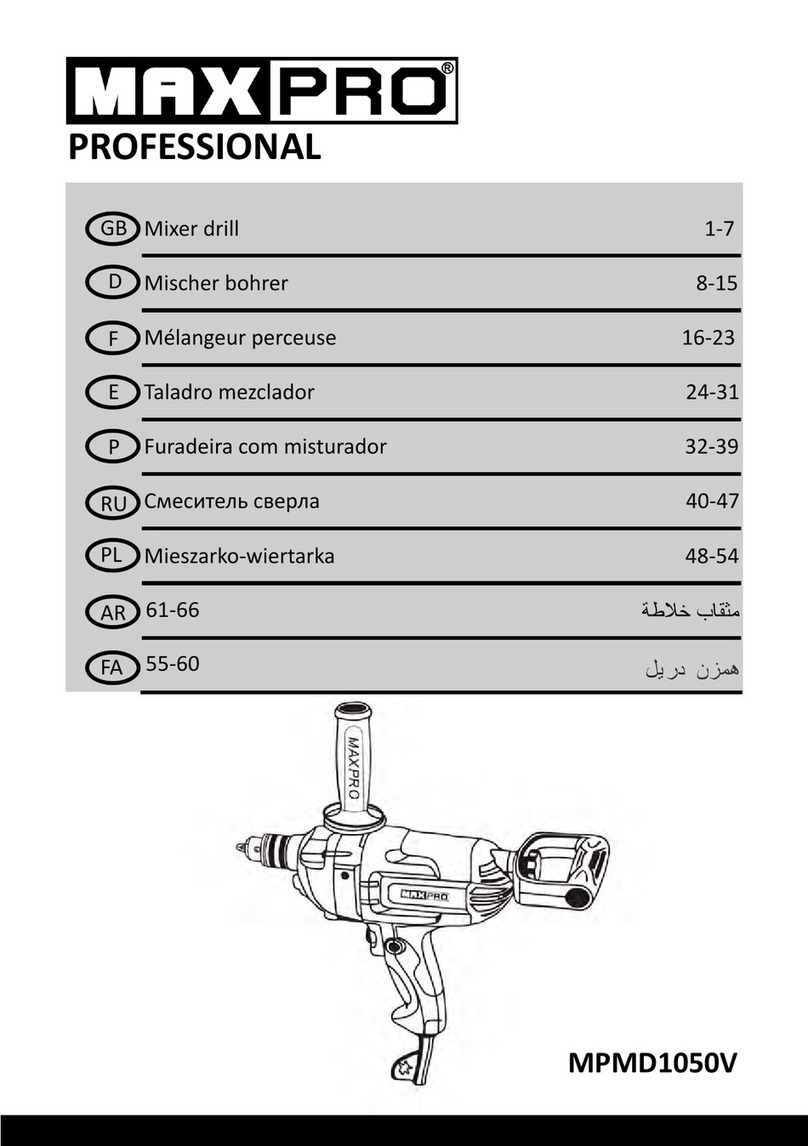
MaxPro PROFESSIONAL
MaxPro PROFESSIONAL MPMD1050V manual

King Industrial
King Industrial KC-35 Assembly and installation
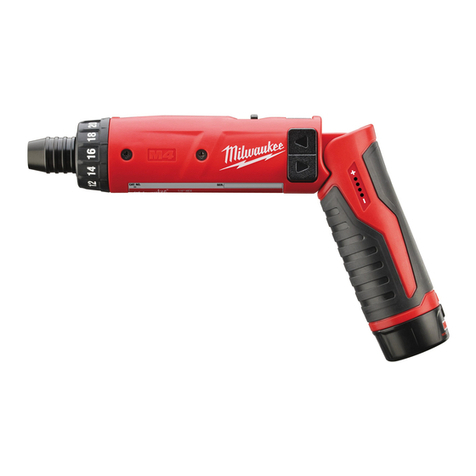
Milwaukee
Milwaukee M4 D user manual
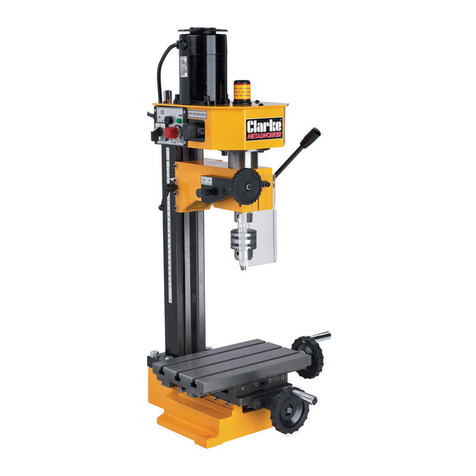
Clarke
Clarke Metalworker CMD10 Operating and maintenance instructions
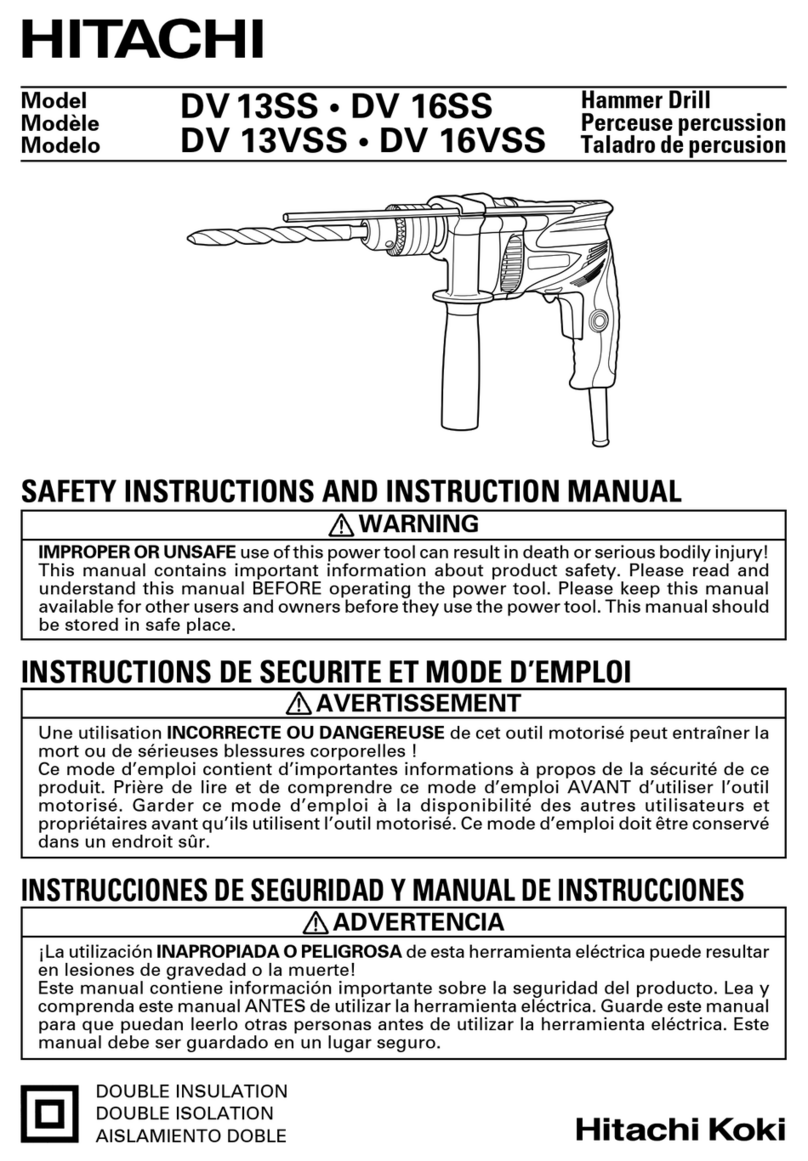
Hitachi
Hitachi DV 16VSS instruction manual
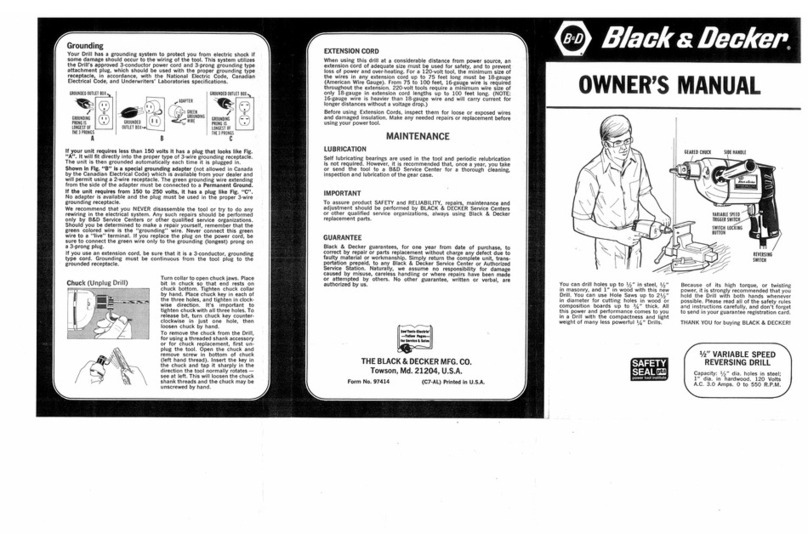
Black & Decker
Black & Decker 97414 owner's manual

